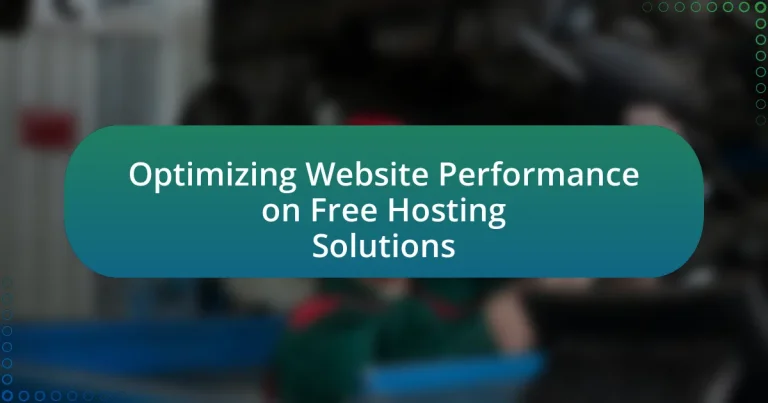Optimizing website performance on free hosting solutions involves enhancing speed, reliability, and user experience through various techniques such as minimizing file sizes, leveraging browser caching, and optimizing images. The article explores how website performance impacts user experience and search engine rankings, emphasizing the importance of fast loading times. It discusses factors contributing to loading speed, strategies for optimization, and the advantages and limitations of free hosting services. Additionally, it highlights the role of content delivery networks (CDNs) and technical optimizations in improving performance, while providing practical tips and tools for ongoing performance monitoring and enhancement.

What is Optimizing Website Performance on Free Hosting Solutions?
Optimizing website performance on free hosting solutions involves enhancing the speed, reliability, and user experience of a website hosted on platforms that do not charge fees. This can be achieved through techniques such as minimizing file sizes, leveraging browser caching, optimizing images, and utilizing content delivery networks (CDNs) to distribute content efficiently. Research indicates that websites that load within two seconds have a significantly lower bounce rate, emphasizing the importance of performance optimization. Additionally, tools like Google PageSpeed Insights can provide actionable recommendations tailored to free hosting environments, ensuring that even limited resources can be utilized effectively for better performance.
How does website performance impact user experience?
Website performance significantly impacts user experience by influencing loading times, responsiveness, and overall satisfaction. Faster loading times lead to lower bounce rates; for instance, a study by Google found that a one-second delay in mobile load times can reduce conversions by up to 20%. Additionally, responsive design and quick interactions enhance user engagement, as users are more likely to stay on a site that performs well. Poor website performance can frustrate users, leading to negative perceptions of the brand and decreased likelihood of return visits.
What factors contribute to website loading speed?
Website loading speed is primarily influenced by factors such as server response time, file sizes, image optimization, and the use of caching. Server response time affects how quickly a server can process requests, with faster servers leading to quicker load times. Large file sizes, including HTML, CSS, and JavaScript, can slow down loading; minimizing these files enhances speed. Image optimization, which involves compressing images without losing quality, significantly reduces loading times. Additionally, caching mechanisms store frequently accessed data, allowing for faster retrieval and improved performance. Studies indicate that a one-second delay in loading time can lead to a 7% reduction in conversions, highlighting the importance of these factors in website performance.
How does performance affect search engine rankings?
Performance directly affects search engine rankings by influencing user experience and engagement metrics. Search engines prioritize websites that load quickly and provide a seamless experience, as these factors correlate with lower bounce rates and higher user satisfaction. For instance, Google has indicated that page speed is a ranking factor, with studies showing that a one-second delay in loading time can lead to a 7% reduction in conversions. Therefore, optimizing website performance, especially on free hosting solutions, is crucial for improving visibility and ranking in search engine results.
Why choose free hosting solutions for website performance optimization?
Free hosting solutions can be chosen for website performance optimization due to their cost-effectiveness and accessibility. These platforms allow users to test and deploy websites without financial investment, making them ideal for startups and small projects. Additionally, many free hosting services offer essential features such as content delivery networks (CDNs) and caching options that can enhance loading speeds and overall performance. For instance, platforms like WordPress.com and GitHub Pages provide built-in optimization tools that help improve site responsiveness. This combination of affordability and performance-enhancing features makes free hosting solutions a viable option for optimizing website performance.
What are the advantages of using free hosting services?
Free hosting services offer several advantages, including cost-effectiveness, ease of use, and accessibility for beginners. These services allow users to create and manage websites without incurring any financial costs, making them ideal for individuals or small businesses with limited budgets. Additionally, many free hosting platforms provide user-friendly interfaces and templates, simplifying the website creation process for those with little technical expertise. Furthermore, free hosting services often include built-in tools for website analytics and basic SEO, enabling users to optimize their online presence without needing advanced skills or additional investments.
What limitations should be considered with free hosting?
Free hosting typically comes with several limitations that can significantly impact website performance. These limitations include restricted bandwidth, which can lead to slow loading times and potential downtime during traffic spikes; limited storage space, which may hinder the ability to host large files or multiple pages; and lack of customer support, making it difficult to resolve technical issues promptly. Additionally, free hosting often includes advertisements placed by the provider, which can detract from the user experience and brand image. Security features are usually minimal, increasing vulnerability to attacks. According to a study by HostingAdvice, 70% of users reported dissatisfaction with the performance of free hosting services, highlighting these common issues.

What strategies can be employed to optimize website performance on free hosting solutions?
To optimize website performance on free hosting solutions, implement strategies such as minimizing file sizes, utilizing content delivery networks (CDNs), and optimizing images. Minimizing file sizes through techniques like minification of CSS and JavaScript reduces load times, which is crucial on limited bandwidth free hosting. Using CDNs can distribute content across multiple servers, decreasing latency and improving access speed for users globally. Additionally, optimizing images by compressing them without significant loss of quality can significantly enhance loading times, as images often constitute the bulk of web page data. These strategies collectively improve user experience and site performance, even within the constraints of free hosting environments.
How can website design influence performance?
Website design significantly influences performance by affecting load times, user experience, and search engine optimization. A well-structured design with optimized images and minimal scripts can reduce loading times, which is crucial as studies show that a one-second delay in page load can lead to a 7% reduction in conversions. Furthermore, intuitive navigation and responsive layouts enhance user engagement, leading to lower bounce rates and higher retention. According to Google, 53% of mobile users abandon sites that take longer than three seconds to load, highlighting the importance of efficient design in maintaining user interest and improving overall site performance.
What design elements should be minimized for better speed?
To improve speed, design elements such as large images, excessive animations, and unnecessary scripts should be minimized. Large images can significantly slow down loading times; for instance, images that are not optimized can take up to 80% of a webpage’s total weight. Excessive animations can lead to increased processing time, particularly on devices with limited resources. Additionally, unnecessary scripts can create delays in rendering, as each script must be downloaded and executed before the page fully loads. Reducing these elements enhances overall performance, particularly on free hosting solutions where resources are limited.
How does responsive design affect performance on free hosting?
Responsive design can negatively affect performance on free hosting due to limited server resources and bandwidth. Free hosting services often provide minimal resources, which can lead to slower loading times when responsive design requires additional CSS and JavaScript for various screen sizes. For instance, a study by Google indicates that mobile-optimized sites can load up to 85% faster than non-optimized sites, but on free hosting, the lack of optimization can counteract these benefits, resulting in increased latency and potential downtime.
What technical optimizations can enhance performance?
Technical optimizations that can enhance performance include implementing content delivery networks (CDNs), optimizing images, and minimizing HTTP requests. CDNs distribute content across multiple servers globally, reducing latency and improving load times. Image optimization techniques, such as compression and using appropriate formats, can significantly decrease file sizes, leading to faster page rendering. Additionally, minimizing HTTP requests by combining CSS and JavaScript files reduces the number of server calls, which enhances overall site speed. These strategies are supported by studies indicating that a 1-second delay in page load time can lead to a 7% reduction in conversions, highlighting the importance of performance optimization.
How can image optimization improve loading times?
Image optimization can significantly improve loading times by reducing the file size of images without sacrificing quality. Smaller image files require less bandwidth and load faster, which enhances user experience and decreases bounce rates. For instance, studies show that optimized images can reduce loading times by up to 80%, leading to faster page rendering and improved SEO rankings. Additionally, tools like JPEGmini and TinyPNG demonstrate that effective compression techniques can maintain visual fidelity while minimizing file size, further validating the impact of image optimization on loading times.
What role does caching play in website performance?
Caching significantly enhances website performance by storing frequently accessed data, which reduces load times and server requests. When a user visits a website, caching allows the browser to retrieve stored resources instead of fetching them from the server each time, leading to faster page rendering. For instance, studies show that implementing caching can decrease load times by up to 50%, improving user experience and engagement. Additionally, reduced server load from caching can lead to lower bandwidth costs and improved scalability, making it particularly beneficial for websites hosted on free solutions with limited resources.

What tools and resources are available for optimizing website performance?
Tools and resources available for optimizing website performance include Google PageSpeed Insights, GTmetrix, and WebPageTest. Google PageSpeed Insights analyzes the content of a web page and provides suggestions to make it faster, offering a score based on performance metrics. GTmetrix combines Google Lighthouse and WebPageTest to provide detailed reports on page load times and recommendations for improvement. WebPageTest allows users to run tests from various locations and browsers, providing insights into loading speed and performance bottlenecks. These tools are widely recognized in the industry for their effectiveness in identifying performance issues and suggesting actionable improvements.
What performance testing tools can be used?
Performance testing tools that can be used include Apache JMeter, LoadRunner, and Gatling. Apache JMeter is an open-source tool widely used for performance testing of web applications, capable of simulating multiple users and generating detailed reports. LoadRunner, developed by Micro Focus, is a commercial tool that supports a wide range of protocols and provides comprehensive analysis features. Gatling is another open-source tool known for its high performance and ease of use, particularly for testing web applications with a focus on HTTP protocols. These tools are validated by their extensive use in the industry and their ability to provide accurate performance metrics essential for optimizing website performance on various hosting solutions.
How do these tools measure website speed and performance?
Website speed and performance measurement tools assess various metrics such as page load time, time to first byte, and overall responsiveness. These tools utilize methods like synthetic testing, which simulates user interactions, and real user monitoring, which collects data from actual visitors. For instance, tools like Google PageSpeed Insights analyze loading times and provide insights based on factors like server response times and resource optimization. Additionally, metrics such as First Contentful Paint and Largest Contentful Paint are evaluated to determine how quickly users perceive the website as loading. These measurements are crucial for identifying bottlenecks and optimizing performance, especially on free hosting solutions where resources may be limited.
What metrics should be monitored for ongoing optimization?
Key metrics to monitor for ongoing optimization include page load time, bounce rate, conversion rate, and user engagement metrics. Page load time is critical as it directly affects user experience; studies show that a one-second delay can reduce conversions by 7%. Bounce rate indicates the percentage of visitors who leave after viewing only one page, with lower rates suggesting better content relevance and user satisfaction. Conversion rate measures the effectiveness of the website in achieving desired actions, such as sign-ups or purchases, and is essential for assessing overall performance. User engagement metrics, such as average session duration and pages per session, provide insights into how users interact with the site, helping to identify areas for improvement. Monitoring these metrics allows for data-driven decisions to enhance website performance on free hosting solutions.
How can content delivery networks (CDNs) assist in performance optimization?
Content delivery networks (CDNs) assist in performance optimization by distributing content across multiple geographically dispersed servers, which reduces latency and improves load times for users. By caching static content closer to the end-users, CDNs minimize the distance data must travel, resulting in faster access to websites. For instance, a study by Akamai found that a 100-millisecond delay in load time can decrease conversion rates by 7%. Additionally, CDNs can handle high traffic volumes and mitigate the impact of traffic spikes, ensuring consistent performance even during peak usage times. This capability is crucial for maintaining user experience and engagement on websites hosted on free hosting solutions, which may have limited resources.
What are the benefits of using a CDN with free hosting?
Using a Content Delivery Network (CDN) with free hosting significantly enhances website performance by improving load times and reliability. CDNs distribute content across multiple servers globally, allowing users to access data from the nearest location, which reduces latency. For instance, studies show that websites utilizing CDNs can experience load time reductions of up to 50%, leading to better user engagement and lower bounce rates. Additionally, CDNs provide increased uptime and reliability, as they can handle traffic spikes and mitigate downtime caused by server overloads. This is particularly beneficial for free hosting solutions, which may have limited resources and bandwidth.
How does a CDN improve load times for global users?
A Content Delivery Network (CDN) improves load times for global users by distributing content across multiple geographically dispersed servers. This distribution allows users to access data from a server that is physically closer to them, reducing latency and speeding up the delivery of web pages. For example, studies show that using a CDN can decrease load times by up to 50% for users located far from the original server, as the CDN caches content and serves it from the nearest location. This mechanism not only enhances user experience but also optimizes bandwidth usage, leading to faster load times for websites hosted on free hosting solutions.
What are some best practices for maintaining optimized performance?
To maintain optimized performance on free hosting solutions, regularly monitor website speed and responsiveness. Utilizing tools like Google PageSpeed Insights can help identify performance bottlenecks, allowing for targeted improvements. Additionally, optimizing images by compressing them without losing quality can significantly reduce load times, as studies show that images can account for up to 70% of a webpage’s total size. Implementing browser caching can also enhance performance by storing frequently accessed resources, reducing server requests. Furthermore, minimizing HTTP requests by combining CSS and JavaScript files can streamline loading processes, leading to faster page rendering. These practices collectively contribute to a more efficient and responsive website experience.
How often should performance audits be conducted?
Performance audits should be conducted at least annually to ensure optimal website performance. Regular audits help identify issues such as slow loading times, broken links, and other performance bottlenecks that can affect user experience and search engine rankings. According to a study by Google, a delay of just one second in mobile page load time can lead to a 20% decrease in conversion rates, highlighting the importance of frequent performance evaluations.
What common pitfalls should be avoided in free hosting environments?
Common pitfalls to avoid in free hosting environments include limited bandwidth, lack of customer support, and security vulnerabilities. Limited bandwidth can lead to slow loading times and downtime, negatively impacting user experience and search engine rankings. The absence of reliable customer support can result in prolonged issues without resolution, affecting website availability. Additionally, free hosting often lacks robust security measures, making websites more susceptible to hacking and data breaches. These factors collectively hinder website performance and reliability, underscoring the importance of careful selection when choosing a hosting solution.
What practical tips can help optimize website performance on free hosting solutions?
To optimize website performance on free hosting solutions, utilize lightweight themes and minimize the use of heavy plugins. Lightweight themes reduce loading times, as they are designed to be efficient and fast. Additionally, minimizing heavy plugins decreases server load and improves response times, which is crucial on limited resources typical of free hosting.
Implementing image optimization techniques, such as compressing images and using appropriate formats, further enhances performance by reducing file sizes without sacrificing quality. Furthermore, leveraging browser caching allows frequently accessed resources to be stored locally on users’ devices, leading to faster load times on subsequent visits.
Finally, regularly monitoring website speed using tools like Google PageSpeed Insights provides actionable insights to identify and rectify performance bottlenecks, ensuring the website remains efficient even on free hosting platforms.




